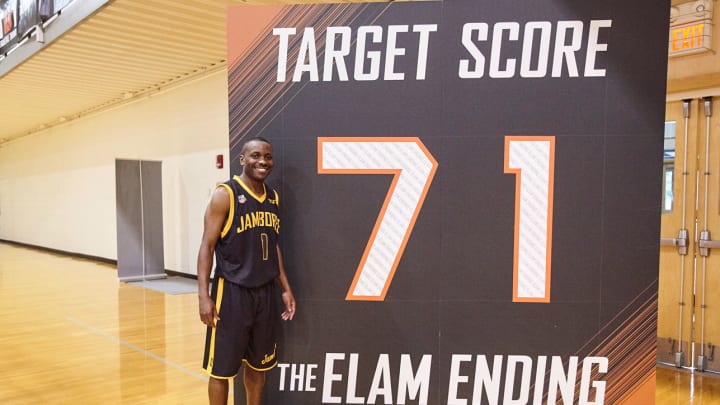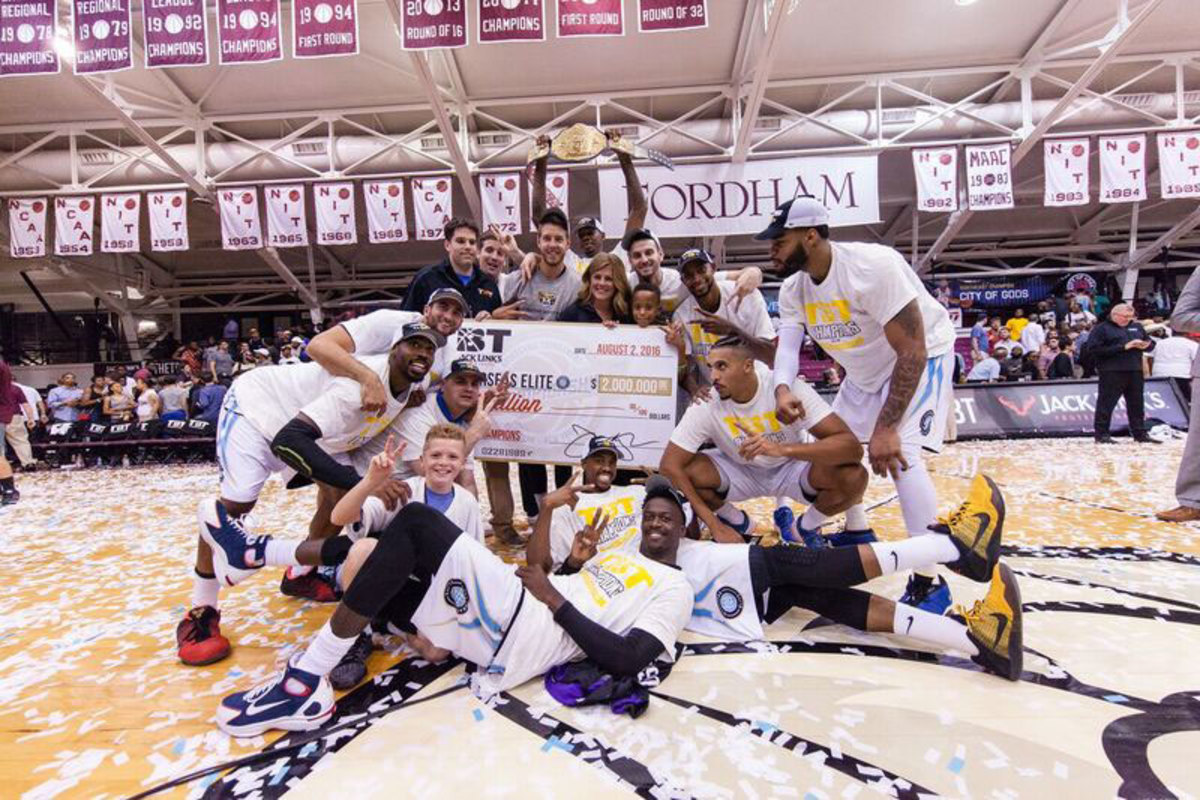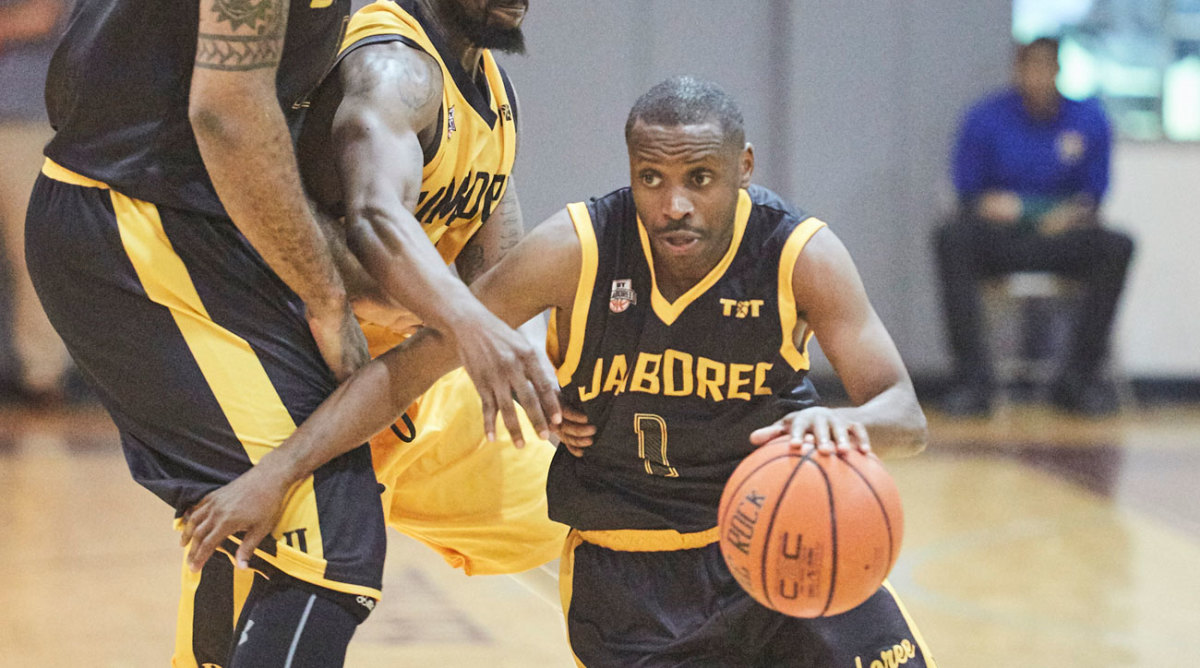The Elam Ending: One Man’s Plan to Eliminate Intentional Fouling

Remember those NBA playoff games a few years ago, in the heyday of Lob City, where opponents would just foul DeAndre Jordan in yet another edition of the NBA’s Hack-a-Shaq strategy? Remember how unentertaining it was to see the game of basketball devolve from peak offensive possessions into a game that was downright offensive—a game that essentially became a foul-shooting competition? Remember how long those games took? How many games ended like that?
Maybe there’s a better way to end games—a way that’s cleaner and more resembles the game of basketball before all those fouls start to pile up.
Enter Nick Elam. A middle school principal, Cincinnati Reds groundskeeper, and Mensa member, Elam has been concocting methods to clean up the conclusions of basketball games for over a decade. Elam watched and catalogued literally thousands of NBA and March Madness games, and found that teams resort to intentional fouling roughly half the time—in this year’s NCAA Tournament alone, teams in 44 of the 70 second halves/overtime periods tried to come back by purposefully fouling. However, according to Elam’s data, in only three of those 44 occasions did the trailing team eventually come back to tie the game or take the lead. The intentional fouling tactic is highly imperfect, but it persists because no alternative solution exists. For now.
2018 NBA Draft Big Board 7.0: Top 100 Prospects
Nick Elam has created one. Instead of playing until the clock hits zero, teams will play until the clock hits a different time—four minutes left in a college game, three in pro—and then the clock shuts off. Seven is added to the leading team’s score, and that total becomes the target score—once either team reaches or surpasses that total, the game is over. For example, Team A leads Team B 80-75 at the first deadball with less than four minutes to go in a college game; the target score becomes 87, and the first team to hit it wins.
Why seven points? The reasoning is actually pretty straightforward. Elam says that this format creates “a hypothetical game time similar to the amount of actual game time removed.” In other words, three minutes in an NBA game (the amount of game time “removed” when the clock shuts off) represents one sixteenth of the total game time of an NBA contest. Seven points, similarly, represents one sixteenth of a typical NBA team’s scoring output—the hypothetical “game time” effectively replaces the actual time removed. The college game works similarly: four minutes represents one tenth of the length of the game, and seven points represents one tenth of the scoring.
Elam called this the “hybrid duration format”. He had the reasoning. He had the gameplan. Now he just needed a court to execute it on.
Summer of Showtime: Why All Eyes Will Be on the Lakers
That’s where Jon Mugar comes in. A student, lover, and former player of the game, Mugar created The Basketball Tournament (TBT) in 2014. It’s a single-elimination, winner-take-all tournament, much like March Madness, but in this event the winner takes all of $2 million. Anyone can play, and, in theory, anyone can win.The 2018 edition takes place in July, with all games airing live on ESPN networks and culminating with the Championship Game on ESPN on August 3.
In 2016, just after the third edition of TBT, Nick Elam emailed Jon Mugar his 67-page PowerPoint presentation about the hybrid duration format. Elam had been spreading the word to anybody and everybody involved in organized basketball for years. A self-described basketball traditionalist, Mugar says he probably would’ve just deleted Elam’s message immediately under most circumstances.

Instead, he was struck by Elam’s passion and attention to punctuation, and decided to give the idea a chance. Mugar rebranded the hybrid duration format “the Elam Ending” and it made its debut in TBT 2017’s preliminary Jamboree round, a sort of extension of March Madness’ First Four, where the top teams make it into the main draw. Basketball fans had 11 games to evaluate the latest idea to fix the sport, and Mugar says it was a smashing success.
“I personally thought it was exhilarating and awesome,” he says. “In the final period, there were a couple of instances where the fans of the team, whether they were winning or losing, sort of re-energized in the arena. There was a palpable feeling during those final moments.”
The experiment produced a lot of different results: a double-digit comeback, a “buzzer-beater” in a one-possession game, and loads of close contests. But in all the variety of endings, one common thread emerged: Mugar says no team resorted to intentional fouling to try to come back.
And that makes sense: why would a trailing team foul and give their opponents a high-percentage chance to get closer to the target score? They would be better served to play defense and try to stop the opponent from getting any points, while creating scoring opportunities for themselves. But of course, it’s basketball, and anything could happen.
LeBron James Saves a Season on the Brink
Still, Mugar says his team believes the Elam Ending solved the problem it was intending to solve—the preponderance of intentional fouls. But did it create additional, unexpected problems for the players who test-drove Nick Elam’s idea for the first time ever? It might have.

Earl Boykins, a veteran of 13 NBA seasons and now a high school coach in Colorado, saw TBT on television one summer, thought it was a great concept, and jumped at the chance to play in it in 2017. His team, Paul Champions, made it through two Jamboree games and into the second round of the main draw. Boykins averaged 24.5 points in his team’s two preliminary-round victories, where he played under the rules of the Elam Ending for the first time.
“It took you back to when you were younger, playing regular pickup basketball,” he says. “In pickup basketball, you always play to a number, whether it’s 11, 12, 16. I view it as it takes basketball back to the purity of the game.”
That might sound good, but Boykins warns that the rule is far from perfect: in fact, he says that the changes only have an impact if your team is losing when the clock is shut off. And the impact is not a positive one.
“If you’re winning, it’s horrible! If you’re losing, it’s great!” he says emphatically. “Do you think the team that was winning [when the clock shut off] benefited from this rule? They didn’t benefit from it. They had to play extra basketball. If it’s a regular game, we’re up 10, we win. I like the rule from an entertainment standpoint only.”
Philly Freedom: Behind the Scenes of Meek Mill’s Release
Here, Boykins hits on one of the only things that Nick Elam hasn’t really addressed in his many defenses of his proposal. In fact, one of Elam’s key points is that his change would increase the likelihood of comebacks, an obvious advantage for the trailing team. He holds that the seven-point target gives the leading team an advantage—after all, the game could be over after three, or maybe even two, possessions. Boykins grants this, but counters that no winning team would willingly trade the safety of the dwindling clock for the stress that comes with the need to score more points. A proposed rule change has to have the potential to benefit all players before they would even consider it, Boykins says.
Perhaps it comes from playing “traditional” basketball for so long, but Boykins questions if there’s even a problem for Nick Elam to fix at all, because even with the incessant intentional fouling, NBA ratings haven’t gone down. And he’s right: the NBA just concluded its highest-rated regular season in five years.
“You’re not going to turn off a Finals game because there’s too much fouling,” he says.
Jon Mugar says that his tournament has the flexibility to tinker with the game of basketball in ways that the NBA and NCAA don’t, and wrinkles implemented in TBT can eventually “filter up” to the big events Mugar grew up admiring. Case in point: this year, March Madness adopted TBT’s tradition of having victorious teams physically move their name placard on a giant tournament bracket on to the next round, one signature (one might say shining) moment that encapsulates the feeling of winning.
“I’ve yet to hear a man complain about winning,” Boykins says with a laugh.
Critics of the Elam Ending have worried that arguably the best element of basketball, the buzzer-beater, would disappear. But Elam maintains, and Boykins reinforces, that the opposite is true: if the target score is, say, 75, and both teams are locked at 74 or 73, the next made shot would win the game, no matter which team makes the shot.
“You’ve basically added a buzzer-beater for both teams,” Boykins says.
The LeBron Vs. Lance Relationship Hasn't Changed At All
There won’t be shots that are literally beat-buzzers (in the second half, anyway), but there will always be a shot that wins the game. That’s always exciting, and that’s exactly what Nick Elam wants.
With the first games of TBT 2018 just over two months away, Jon Mugar has a decision to make. Gone is the Jamboree round, so if TBT implements the Elam Ending this year, it will be an all-or-nothing affair: either every game uses the new rule, or none of them do. There is a slight compromise, however: if Mugar votes no on the Elam Ending, any overtime game in TBT 2018 would be first-to-seven wins, a sort of variation on the Elam Ending.
To make his decision, Mugar will weigh his own experiences with both sets of rules, along with impressions from executives, players, broadcasters, and, of course, Nick Elam himself.
“Nick’s done an unbelievable job convincing me that this is something that should be considered pretty seriously,” Mugar says. “I just want to make sure everyone involved is comfortable with it.”
TBT did its postgame bracket celebration for four years before the NCAA took notice and incorporated it into its own event. Who knows? If TBT implements the Elam Ending and it works, maybe we could see it in basketball’s upper echelons in a few years, too.
